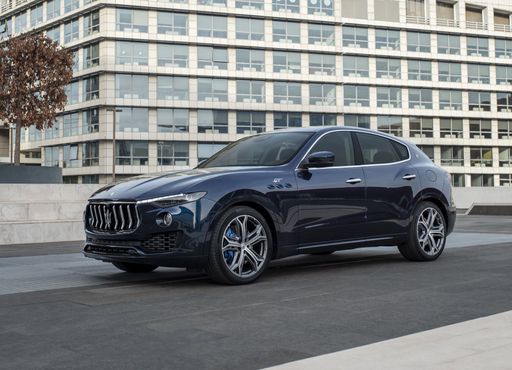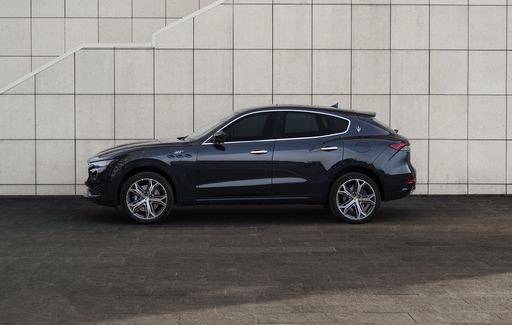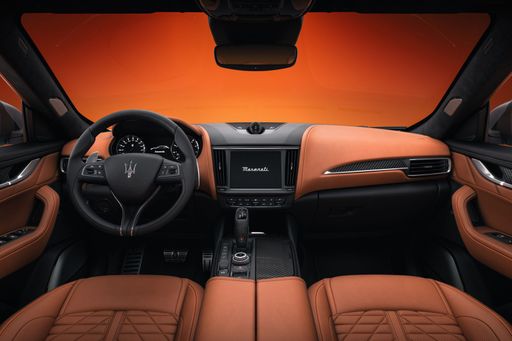Renault Trafic Bus vs Maserati Levante – Differences & prices compared
Compare performance, boot space, consumption and price in one view.
Find out now: which car is the better choice for you – Renault Trafic Bus or Maserati Levante?
The Renault Trafic Bus (Bus) comes with a Diesel engine and Manuel transmission. In comparison, the Maserati Levante (SUV) features a Petrol MHEV or Petrol engine with Automatic transmission.
When it comes to boot capacity, the Renault Trafic Bus offers , while the Maserati Levante provides 580 L – depending on how much space you need. If you’re looking for more power, decide whether the 150 HP of the Renault Trafic Bus or the 430 HP of the Maserati Levante suits your needs better.
In terms of consumption, the values are 6.80 L per 100 km for the Renault Trafic Bus, and 9.70 L for the Maserati Levante.
Price-wise, the Renault Trafic Bus starts at 38200 £, while the Maserati Levante is available from 93900 £. Compare all the details and find out which model fits your lifestyle best!
Renault Trafic Bus
The Renault Trafic Bus is a versatile and spacious option for those needing to transport multiple passengers comfortably. With its modern design and practical features, it is well-suited for both business and leisure purposes. Its efficient engine and smooth handling make it a reliable choice for long journeys.
detailsMaserati Levante
The Maserati Levante exudes a perfect harmony between dynamic elegance and rugged capability, making it a standout in the luxury SUV segment. Its distinctive Italian design is complemented by a sumptuous interior that offers both comfort and cutting-edge technology for an unparalleled driving experience. With a focus on performance, the Levante delivers a thrilling ride, ensuring that Maserati's dedication to speed and style is evident in every journey.
details @ media.maserati.com
@ media.maserati.com
 @ media.maserati.com
@ media.maserati.com
 @ media.maserati.com
@ media.maserati.com

|
|
|
|
|
Costs and Consumption |
|
|---|---|
|
Price
38200 - 51100 £
|
Price
93900 - 125800 £
|
|
Consumption L/100km
6.8 - 7.2 L
|
Consumption L/100km
9.7 - 12.1 L
|
|
Consumption kWh/100km
-
|
Consumption kWh/100km
-
|
|
Electric Range
-
|
Electric Range
-
|
|
Battery Capacity
-
|
Battery Capacity
-
|
|
co2
179 - 188 g/km
|
co2
221 - 273 g/km
|
|
Fuel tank capacity
80 L
|
Fuel tank capacity
80 L
|
Dimensions and Body |
|
|---|---|
|
Body Type
Bus
|
Body Type
SUV
|
|
Seats
8 - 9
|
Seats
5
|
|
Doors
4
|
Doors
4
|
|
Curb weight
2031 - 2321 kg
|
Curb weight
2165 - 2184 kg
|
|
Trunk capacity
-
|
Trunk capacity
580 L
|
|
Length
5080 - 5480 mm
|
Length
5005 mm
|
|
Width
1956 mm
|
Width
1981 mm
|
|
Height
1973 - 1974 mm
|
Height
1693 mm
|
|
Payload
749 - 982 kg
|
Payload
316 - 615 kg
|
Engine and Performance |
|
|---|---|
|
Engine Type
Diesel
|
Engine Type
Petrol MHEV, Petrol
|
|
Transmission
Manuel
|
Transmission
Automatic
|
|
Transmission Detail
Manual Gearbox
|
Transmission Detail
Automatic Gearbox
|
|
Drive Type
Front-Wheel Drive
|
Drive Type
All-Wheel Drive
|
|
Power HP
110 - 150 HP
|
Power HP
330 - 430 HP
|
|
Acceleration 0-100km/h
13.6 - 16.5 s
|
Acceleration 0-100km/h
5.2 - 6 s
|
|
Max Speed
161 - 174 km/h
|
Max Speed
245 - 264 km/h
|
|
Torque
300 - 350 Nm
|
Torque
450 - 580 Nm
|
|
Number of Cylinders
4
|
Number of Cylinders
4 - 6
|
|
Power kW
81 - 110 kW
|
Power kW
243 - 316 kW
|
|
Engine capacity
1997 cm3
|
Engine capacity
1995 - 2979 cm3
|
General |
|
|---|---|
|
Model Year
2023 - 2024
|
Model Year
2023
|
|
CO2 Efficiency Class
G
|
CO2 Efficiency Class
G
|
|
Brand
Renault
|
Brand
Maserati
|
Renault Trafic Bus
A Glimpse into the Renault Trafic Bus: An Icon of Versatility and Innovation
Amongst the plethora of vans designed for both business and leisure, the Renault Trafic Bus stands out as an exemplar of functionality, innovation, and style. Let's delve into what makes the Renault Trafic Bus a popular choice in the UK and across Europe, particularly focusing on its technical specifications and state-of-the-art features.
Performance Dynamics: Power Under the Hood
The Renault Trafic Bus, a staple in Renault's fleet, is driven by a robust diesel engine configuration with power outputs ranging from 110 PS to a formidable 170 PS. The diesel engines combine efficiency and power, offering torque figures between 300 to 380 Nm, ensuring smooth power delivery and capable load hauling.
Drivers can choose between manual and automatic transmissions, both designed to complement the Trafic's front-wheel-drive system. This flexibility ensures that drivers experience enhanced driving comfort whether they are navigating urban roads or cruising on the motorway.
Efficiency Meets Economy
The Trafic Bus showcases impressive fuel economy with consumption figures ranging from 6.8 to 7.2 litres per 100 kilometres. This efficiency is crucial for businesses aiming to minimise operational costs and for families seeking budget-friendly travel options.
With a generous fuel tank capacity of 80 litres, the Renault Trafic Bus is built to cover long distances with fewer fuel stops, making it an ideal choice for long haul journeys.
Technological Innovations and Comfort
The Trafic Bus isn't just about robust performance. Renault has integrated a suite of technological innovations designed to enhance driver and passenger comfort. Its cabins are equipped with the latest infotainment systems and safety technologies, providing an optimal blend of comfort and convenience.
The various trims, such as Life, Start, Spaceclass, and their respective EDC variants, cater to different needs and preferences, ensuring that customers can find the perfect configuration for their requirements.
Design and Dimensions: Space for Every Purpose
Space and versatility are at the heart of the Trafic Bus design. With its dimensions ranging from a length of 5080 to 5480 mm, and a width of 1956 mm, this vehicle offers ample room for passengers and cargo alike. The height stands between 1973 and 1974 mm, ensuring that even taller individuals can travel comfortably.
With seating for up to eight people and a payload capacity between 730 to 1010 kg, the Trafic Bus can transform seamlessly between a people-mover and a goods carrier.
Environmental Considerations
Renault has engineered the Trafic Bus with environmental responsibility in mind. The CO2 emissions range from 178 to 190 g/km, which, while modest for its class, aligns with the efficiency and performance goals set for this versatile vehicle. The CO2 efficiency class is rated as 'G', offering transparency in its environmental impact profile.
Conclusion: A Leader in Its Class
The Renault Trafic Bus continues to lead its segment through a blend of power, efficiency, and technological advancements. Whether it's for commercial transport or family adventures, the Trafic offers a reliable and adaptable solution, setting a high standard for multi-purpose vehicles.
For those seeking a distinguished blend of utility and comfort, the Renault Trafic Bus emerges as an exceptional choice, promising performance and innovation on every journey.
Maserati Levante
The Elegance and Power of the Maserati Levante
The Maserati Levante is the quintessential blend of power, luxury, and cutting-edge technology, bringing the revered Italian brand's iconic essence into the SUV segment. Tailored perfectly for those who demand both performance and style, the Levante is a remarkable showcase of Maserati's dedication to crafting beautifully engineered automobiles. Let's delve into the technical details and myriad innovations that make the Levante a standout choice in its class.
Under the Bonnet: Engineering Excellence
At the heart of the Maserati Levante, you'll find an impressive range of powertrains, catering to numerous tastes and driving preferences. The Levante offers a sophisticated blend of a petrol mild-hybrid system and classic petrol engines, ensuring a captivating driving experience across its variants. Engine outputs range from 330 to 430 PS (243 to 316 kW), sustained by an optimised automatic transmission that guarantees smooth and responsive handling. With an all-wheel-drive system as standard, the Levante is engineered to tackle diverse driving conditions effortlessly.
Performance that Excites
The Levante takes performance seriously, evident from its remarkable acceleration capabilities. It can sprint from 0 to 100 km/h in as little as 5.2 seconds, achieving exhilarating speed with the elegance and poise typical of a Maserati. The Levante’s top speed ranges between 245 and 264 km/h, pushing the boundaries of what's possible for an SUV in its class. The powertrain, coupled with a perfectly tuned chassis, provides a driving experience that is truly pulse-raising.
Luxury Meets Innovation
Beyond its performance credentials, the Maserati Levante encapsulates luxury and advanced technology. The interior is meticulously designed, offering a premium experience with high-quality materials and cutting-edge features. As a part of the Ultima Automatik trim, it brings exclusive package options aimed at enhancing both comfort and functionality. With a seating capacity of five and a spacious 580-litre boot, the Levante seamlessly combines practical utility with lavish luxury.
Efficiency and Environmental Considerations
While performance is at its core, the Maserati Levante also contests modern standards by integrating technology aimed at improving fuel efficiency. Its consumption figures range from 9.7 L/100km to 12.1 L/100km, reflecting its dual focus on power and efficiency. While the CO2 emissions stand between 221 to 273 g/km, the Levante adheres to modern efficiency norms while delivering unmatched performance.
Sculpted Design: A Visual Masterpiece
The visual appeal of the Maserati Levante matches its robust performance. With dimensions spanning 5005 mm in length, 1981 mm in width, and 1693 mm in height, this SUV commands presence on the road. Its striking design is complemented by aerodynamics honed to perfection, contributing not only to its aesthetic allure but also to its dynamic performance capabilities. Each curve and line on the Levante underlines Maserati’s commitment to automotive artistry.
The Maserati Levante: A New Era of SUVs
The Maserati Levante is more than just an SUV; it's a statement of sophistication, engineering prowess, and luxury lifestyle. With a starting price reflective of its premium attributes, this SUV remains an epitome of Italian automotive excellence, packing a memorable driving experience into every journey.
The prices and data displayed are estimates based on German list prices and may vary by country. This information is not legally binding.
